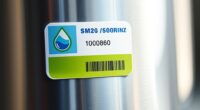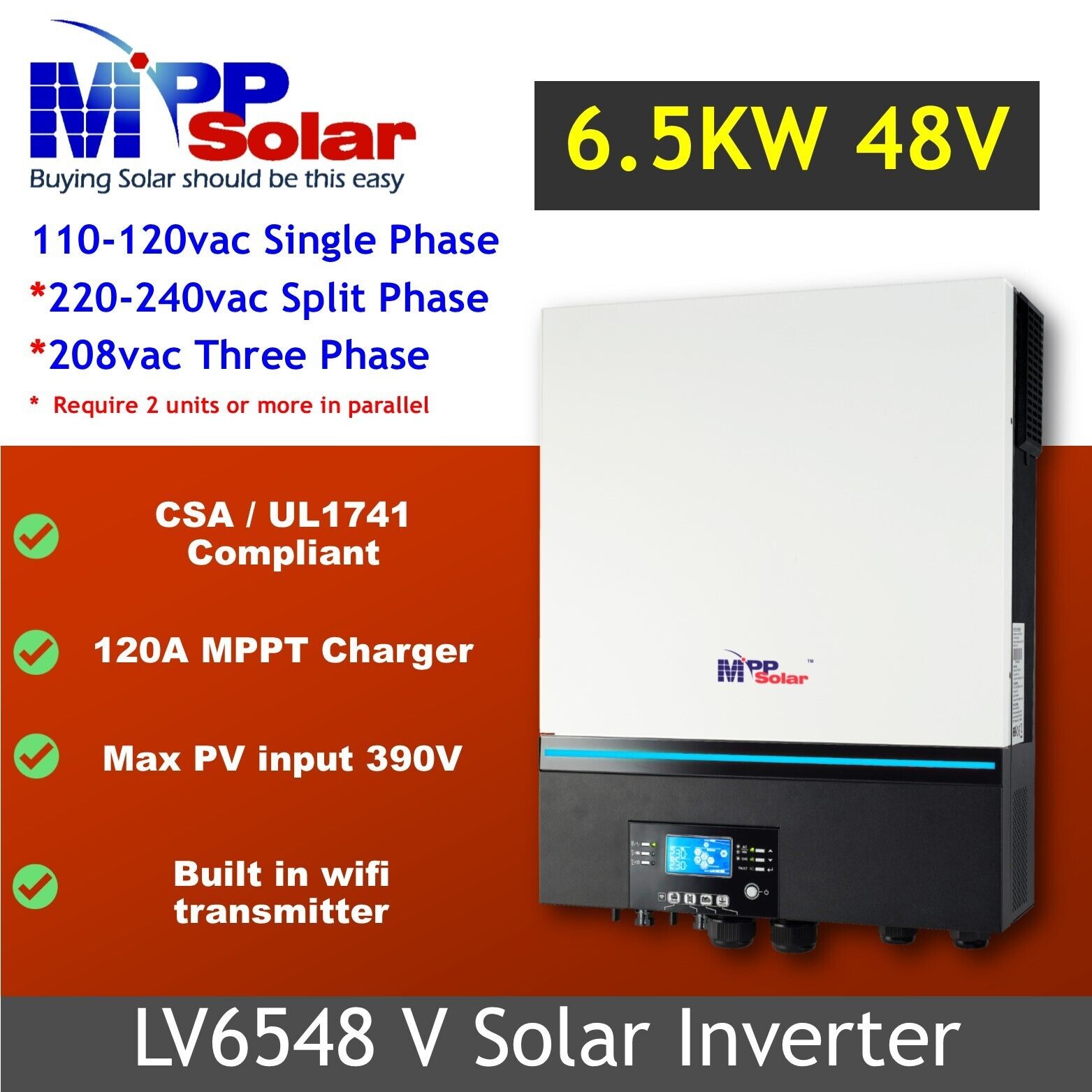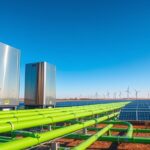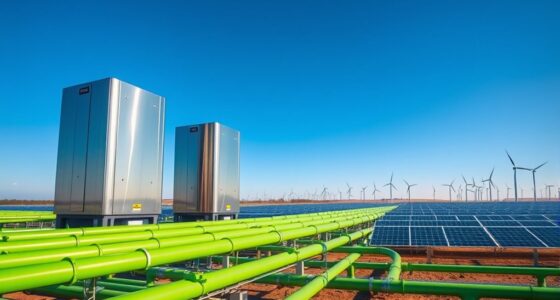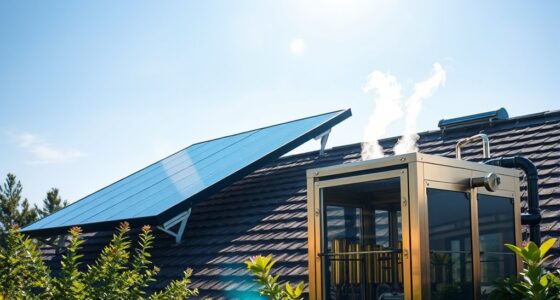Hybrid hydrogen-battery systems require precise sizing models to balance short-term power demands with long-term storage needs. You’ll need to contemplate factors like hydrogen tank capacity, battery size, efficiency, and safety standards to optimize performance and costs. Different approaches use mathematical optimization and scenario analysis to find the best mix for your goals. If you want to explore how to develop these models and tackle system challenges, there’s more to discover ahead.
Key Takeaways
- Mathematical models optimize the sizing of hydrogen storage and batteries to balance cost, reliability, and system performance.
- Scenario-based simulations evaluate system behavior under renewable variability and load fluctuations for optimal component sizing.
- Multi-criteria optimization techniques consider trade-offs among system size, efficiency, and environmental impact.
- Hybrid sizing approaches integrate hydrogen and battery capacities to enhance resilience and reduce total system costs.
- Advanced algorithms, such as metaheuristics and machine learning, improve the accuracy and robustness of optimal sizing models.
Understanding Hybrid Hydrogen-Battery Systems

Hybrid hydrogen-battery systems combine multiple components to efficiently generate, store, and use energy. At their core, you’ll find a fuel cell stack that converts hydrogen and oxygen into electricity, providing power directly. An auxiliary battery kicks in to start the system and runs auxiliary loads. The battery pack stores energy from regenerative processes and supplements power when needed. To produce hydrogen for storage, an electrolyzer uses electricity, which is then stored in hydrogen tanks onboard or onsite. These tanks supply fuel to the fuel cells, ensuring continuous energy flow. This integration allows the system to balance renewable sources, like solar, with hydrogen and battery storage. Hydrogen gas as an energy carrier is stable and cost-effective, understanding how these components work together lays the foundation for optimizing system performance and reliability in varied applications. Additionally, energy storage efficiency plays a crucial role in maximizing the system’s overall effectiveness and ensuring consistent power supply.
Key Benefits of Combining Batteries and Hydrogen Storage

Combining batteries and hydrogen storage gives you greater energy flexibility and scalability, allowing systems to adapt to varying demand and renewable supply. This hybrid approach also offers cost-effective storage solutions by reducing battery size and maintenance needs. Additionally, integrating both technologies enhances system reliability, ensuring continuous power even during outages or high load periods. Batteries’ finite energy capacity can be complemented by hydrogen storage, enabling longer-term energy resilience and reducing downtime. Furthermore, hydrogen’s renewable production methods support sustainable energy systems by utilizing excess renewable energy for hydrogen generation.
Enhanced Energy Flexibility
Integrating batteries with hydrogen storage creates a highly responsive energy system capable of handling both short-term fluctuations and long-term supply needs. This synergy allows you to respond swiftly to grid changes while managing seasonal variability. Batteries provide rapid charge/discharge for immediate needs, while hydrogen offers larger-scale, slower discharge for extended periods. This combination enhances your system’s flexibility, reducing dependence on external power sources during peak demand or low renewable generation. You can also better manage diurnal and seasonal energy shifts, ensuring stability and reliability. Additionally, understanding battery operation and how it complements hydrogen storage can optimize overall system performance.
Cost-Effective Storage Solutions
Using both batteries and hydrogen storage together can substantially boost your energy system’s efficiency and cost-effectiveness. By combining these technologies, you leverage each system’s strengths—batteries deliver quick energy response, while hydrogen provides long-term, large-scale storage. Hydrogen can be produced from diverse renewable sources, increasing flexibility and sustainability. Renewable energy sources enhance the overall environmental benefits of hybrid systems. Hybrid systems are easily scalable, adapting to different energy needs, and can reduce infrastructure costs by integrating storage options. This combination offers significant long-term savings, with studies indicating potential net benefits of over $211,000. Operational costs decrease as hydrogen production from renewables lowers expenses, and emerging technologies improve energy density and system efficiency. Additionally, hybrid systems can optimize the use of surplus renewable energy, minimizing waste and maximizing system utilization thereby enhancing overall efficiency. Overall, hybrid storage solutions present a practical, cost-effective approach to achieving reliable, sustainable energy management.
Improved System Reliability
Hybrid hydrogen-battery systems considerably enhance overall system reliability by providing a stable and resilient power supply. They ensure continuous operation through hydrogen fuel cells, which deliver consistent power as long as hydrogen is available. Their long lifespan and minimal maintenance needs reduce operational disruptions. Scalability allows for easy expansion to meet growing demands without compromising reliability. Additionally, integrating with renewable energy sources stabilizes power delivery during fluctuations or outages. You benefit from:
- Backup power capabilities, ensuring uninterrupted supply during grid failures
- Energy independence, reducing reliance on external grids
- Grid stability, supporting overall network resilience
- Reduced outage risks, thanks to reliable backup solutions
- Flexible deployment, adaptable for both temporary and permanent needs
This combination creates a robust, adaptable, and sustainable energy system, significantly improving reliability. Furthermore, the integration of diverse energy storage options, such as batteries and hydrogen, enhances system capacity and resilience against supply disruptions.
Mathematical Approaches to Optimal System Sizing
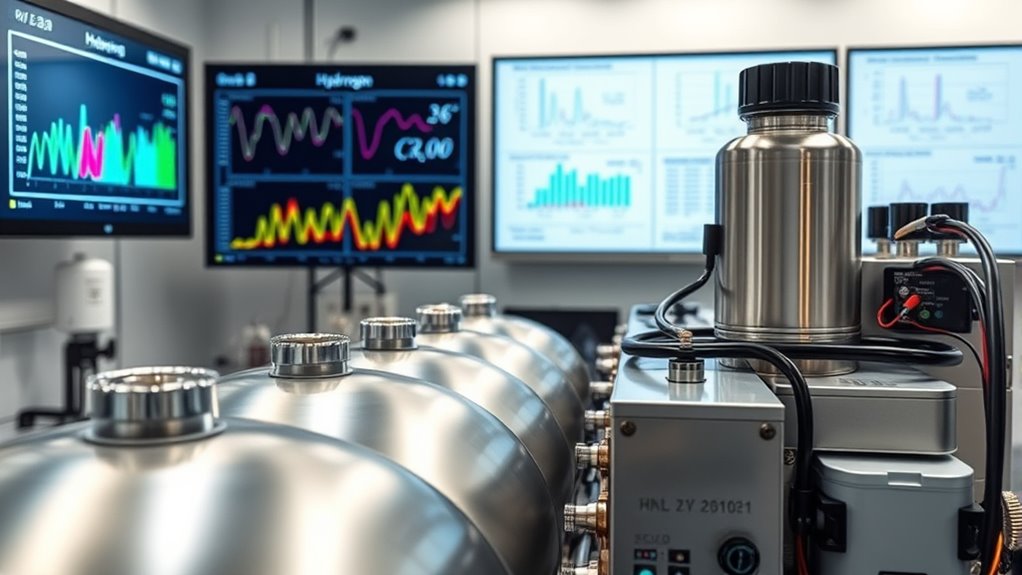
Mathematical approaches play a crucial role in achieving the best system sizing for hybrid hydrogen-battery systems. They enable precise balancing of energy flows, component efficiencies, and costs. Deterministic models like the Balanced Method optimize system design by minimizing surplus energy and losses through constraints on hydrogen production, electrolyzer capacity, and fuel cell ratings. Metaheuristic algorithms such as Harris Hawks or Scatter Search improve solutions by exploring complex solution spaces and handling variability. Hybrid techniques combine the strengths of multiple methods for enhanced robustness. These approaches incorporate equations linking hydrogen volume, energy input, and system efficiencies, while constraints ensure technical feasibility. Moreover, recent advancements utilize machine learning techniques to predict system performance and inform optimization strategies, further enhancing design accuracy and efficiency. The table below summarizes key methods used in this mathematical optimization landscape:
| Method | Focus |
|---|---|
| Deterministic Models | Energy balance and efficiency |
| Metaheuristic Algorithms | Cost minimization and solution exploration |
| Scatter Search | Solution diversification and intensification |
| Constraint-Based Formulations | Technical and operational limits |
Factors Influencing Storage Component Selection

Selecting the right storage components for hybrid hydrogen-battery systems depends on several critical factors that directly impact safety, efficiency, and longevity. Material compatibility is essential—choose stainless steel with at least 10–12% nickel to prevent hydrogen embrittlement and guarantee corrosion resistance. High-pressure tolerance influences tank design, as hydrogen vehicles operate at 350–700 bar. Leak-proof fittings and adherence to ASTM standards safeguard against leaks. System efficiency and performance are affected by hydrogen’s lower roundtrip efficiency compared to batteries and its temperature sensitivity, requiring proper thermal management. Storage duration and capacity also matter; hydrogen is better for long-term, large-scale storage, while batteries excel for short durations. Hydrogen embrittlement can cause material cracking and brittleness, compromising system integrity. Additionally, ongoing research in material science aims to develop more resilient storage materials to enhance safety and durability. Consider these factors carefully to optimize system safety, performance, and reliability.
Balancing Cost, Reliability, and Environmental Goals

Balancing cost, reliability, and environmental goals requires careful system sizing and operational strategies. You can optimize expenses through economies of scale and incentives, while maintaining system dependability with redundancy and predictive maintenance. Additionally, prioritizing renewable-powered hydrogen production and minimizing resource impacts helps reduce the environmental footprint effectively. Incorporating high-efficiency components can further enhance system performance and sustainability.
Cost-Effectiveness Strategies
Achieving cost-effectiveness in hybrid hydrogen‑battery systems requires carefully integrating multiple strategies to balance expenses, reliability, and environmental goals. You need to optimize system sizing by balancing capital and operational costs while ensuring dependable energy supply. Consider these approaches:
- Use mathematical optimization to find configurations that meet demand at the lowest total annual cost.
- Balance battery capacity for quick response against hydrogen storage for long-term energy, minimizing both costs and degradation.
- Scale hydrogen tanks to reduce battery stress but weigh against higher infrastructure investments.
- Incorporate scenario-based simulations to account for renewable variability and load fluctuations.
- Leverage multi-criteria optimization to trade off reliability, system size, and cost effectively.
- Aura visualization techniques can be employed to monitor system performance and energy flow, aiding in more accurate sizing decisions.
Environmental Impact Optimization
Integrating cost-effectiveness strategies with environmental impact considerations guarantees that hybrid hydrogen-battery systems not only save money but also minimize their ecological footprint. By using renewable energy sources like solar and wind for hydrogen production, you markedly cut carbon emissions compared to fossil fuels. Optimizing energy efficiency through hybrid systems reduces waste and boosts overall performance. You must also manage battery and hydrogen storage end-of-life carefully to limit environmental harm. Be mindful of land use and water consumption; deploying renewables requires space and water resources, demanding sustainable practices. Lifecycle assessments help evaluate the entire environmental impact of the system from production to disposal, ensuring comprehensive sustainability. Advanced optimization techniques help balance system reliability with environmental goals, ensuring stable energy supply while minimizing waste. Incorporating policies and incentives accelerates adoption, further aligning economic, technical, and ecological objectives. Implementing lifecycle assessments ensures comprehensive environmental impact evaluation throughout the system’s lifespan.
Case Studies Demonstrating Practical Applications

Case studies of hybrid hydrogen-battery systems showcase their real-world applications across various sectors. In mobile refuelling, Fuel Cell Systems developed three generations of hydrogen trucks, progressively integrating advanced storage and battery tech for off-grid, zero-emission operation. These trucks supported projects like hydrogen trains, scooters, and aviation. For off-grid power, hybrid systems combining solar and methanol fuel cells keep remote wind measurement stations operational, ensuring critical data collection. Industrial-scale facilities in Germany demonstrate seamless integration of solar, hydrogen, and batteries for vehicle refuelling and testing. In community projects, solar-hydrogen-battery setups provide reliable power in rural areas like Sarawak, addressing energy access challenges. These case studies highlight the versatility and practicality of hybrid systems in diverse environments and applications.
Hybrid hydrogen-battery systems enable sustainable off-grid power and mobile refuelling solutions worldwide.
- Off-grid power for renewable site assessment
- Mobile hydrogen refuelling trucks
- Industrial demonstration of multi-energy hybrid systems
- Rural electrification initiatives
- Optimization for cost and performance
Challenges in Integrating Hydrogen and Battery Technologies

Combining hydrogen and battery technologies presents numerous challenges that can hinder their seamless deployment. You’ll face high costs and efficiency issues in hydrogen production, mainly from renewable sources, and early-stage technology limits. Scaling hydrogen requires reliable renewables and advanced electrolyzers. Infrastructure isn’t compatible, demanding costly retrofits, and pipeline integration remains complex. Safety risks, like flammability and leak detection, add hurdles, alongside technical issues such as corrosion and material durability. Market and policy barriers slow adoption, while energy losses during storage reduce system efficiency. Overcoming these obstacles involves balancing technical, economic, and safety factors.
| Challenge Area | Key Concern |
|---|---|
| Production & Efficiency | High costs, low efficiency, material durability |
| Infrastructure | Compatibility, retrofitting, pipeline integration |
| Safety | Flammability, leak detection, safety protocols |
| Technical | Corrosion, catalyst development, system integration |
| Market & Policy | Adoption barriers, market readiness |
Advances in Simulation and Optimization Tools

You can leverage advanced simulation software to quickly model hybrid hydrogen-battery systems and evaluate different configurations. Scenario-transformation techniques help optimize system performance by adapting to various mission profiles, while multi-criteria approaches balance factors like efficiency and lifespan. These tools enable precise system sizing and operation decisions, driving better integration of hydrogen and battery technologies. Developing accurate models of fuel cell degradation and dynamic behaviour allows for even more reliable and efficient system optimization.
Scenario-Transformation Techniques
Advances in simulation and optimization tools have revolutionized how hybrid hydrogen-battery systems are analyzed and designed by enabling more thorough scenario transformation techniques. You can now generate diverse scenario parameters using probabilistic methods, sampling from distributions like truncated normal or uniform, based on peer-reviewed data. These approaches capture a wider range of potential system states, accounting for uncertainties more effectively. High-performance computing accelerates simulations, allowing large scenario ensembles to be processed efficiently with parallel workflows and advanced solvers. You can incorporate stochastic modeling to reflect forecast errors and variable correlations, improving realism. Additionally, multi-indicator analyses evaluate scenarios from multiple perspectives, encompassing reliability, costs, and environmental impacts, *therefore* supporting robust decision-making.
- Scenario parameter sampling from distributions
- Probabilistic uncertainty modeling
- High-performance computing acceleration
- Multi-scenario and stochastic generation
- Multi-criteria scenario evaluation
Multi-Criteria Optimization Approaches
Multi-criteria optimization approaches play a crucial role in designing hybrid hydrogen-battery systems by balancing multiple, often conflicting objectives such as cost, reliability, and environmental impact. These frameworks help you select ideal sizes for hydrogen and battery storage units by integrating diverse criteria like system performance, lifecycle costs, and ecological effects. Using methods like weighted sums, goal programming, or evolutionary algorithms, you can handle trade-offs efficiently, ensuring a balanced design. Multi-objective models, such as Pareto front analysis, allow you to identify efficient solutions without prioritizing any single goal. Incorporating both storage types, these approaches optimize system flexibility and resilience while considering investment, operational costs, and environmental metrics. This holistic view ensures your hybrid system is cost-effective, reliable, and sustainable. These models facilitate comprehensive decision-making, enabling designers to navigate complex trade-offs and achieve optimal system configurations.
Advanced Simulation Software
Advanced simulation software has become essential for designing and optimizing hybrid hydrogen-battery systems, as it enables detailed modeling of complex interactions within the system. You can leverage digital twin technology to simulate entire fuel cell systems, integrating components and control logic at a system level. These tools allow rapid scenario testing, helping you evaluate performance without costly prototypes. They handle thermodynamic, electrochemical, and fluid dynamic phenomena crucial for fuel cell operation and thermal management. Additionally, software modules support battery charging/discharging, energy management, and custom control algorithms. Data export features facilitate further analysis in platforms like MATLAB and Excel. This all-encompassing approach enhances confidence in system behavior predictions, reduces development costs, and accelerates the path toward optimized, safe, and efficient hybrid hydrogen-battery solutions. Advanced simulation software also enables real-time monitoring and predictive maintenance, which are vital for ensuring long-term system reliability and safety.
Future Trends in Hybrid Storage System Design

The future of hybrid storage system design will be shaped by innovations that seamlessly integrate diverse energy storage technologies to meet evolving grid and market demands. You’ll see emerging alternatives to lithium-ion batteries, like sodium-ion and solid-state options, offering better safety, energy density, and cost-effectiveness. Hybrid systems combining lithium-ion with supercapacitors will enable rapid response and long-duration storage, perfect for grid balancing and renewable integration. Advances in redox flow batteries and AI-enhanced large-capacity BESS will boost system resilience and scalability. Additionally, PV and storage integration will accelerate, supporting commercial and EV charging applications. These trends will drive more flexible, efficient, and reliable hybrid solutions, ultimately transforming how energy is stored, managed, and deployed across diverse sectors. The integration of AI and machine learning will further optimize system performance and predictive maintenance, enhancing overall reliability and operational efficiency.
Policy and Market Drivers for Hybrid Energy Solutions

Policies and market forces play a decisive role in shaping the adoption of hybrid hydrogen-battery systems. Government incentives, such as subsidies and clean energy mandates, lower costs and boost demand. Market growth is driven by declining renewable tech costs, urbanization, and increased electrification, which require reliable, sustainable solutions. Additionally, policies promoting infrastructure modernization and grid resilience encourage hybrid storage deployment. You’ll find that:
- Subsidies and incentives make hybrid systems more affordable.
- Emission reduction policies push sectors to adopt hybrid solutions.
- Feed-in tariffs enhance renewable energy’s economic viability.
- Environmental regulations drive corporate and industrial adoption.
- Public-private partnerships accelerate pilot projects and commercialization.
These drivers align with broader trends supporting hybrid energy’s role in achieving energy security, decarbonization, and system flexibility.
Frequently Asked Questions
How Do Hybrid Systems Perform During Prolonged Renewable Energy Shortages?
During prolonged renewable energy shortages, hybrid systems excel by combining battery and hydrogen storage. You benefit from batteries’ quick response to demand spikes and hydrogen’s ability to store energy long-term. This setup stabilizes your grid, maintains power supply, and reduces reliance on fossil fuels. As technological advancements continue, your hybrid system becomes more efficient and cost-effective, ensuring reliable energy even during extended periods of low renewable generation.
What Safety Measures Are Essential for Hydrogen Storage in Hybrid Systems?
You must implement essential safety measures for hydrogen storage, including complying with standards like FMVSS No. 308 and SAE J2579 to guarantee structural integrity and safety. Regular inspections and rigorous testing help detect weaknesses early. Use robust seals and redundant containment to prevent leaks, and install continuous monitoring systems for prompt leak detection. Emergency protocols, ventilation, and operator training further ensure safe handling, reducing risks during storage and operation.
How Does System Scalability Affect Hybrid Storage Cost-Effectiveness?
You’ll find that system scalability greatly enhances hybrid storage cost-effectiveness. As storage capacity grows, hydrogen tanks become cheaper per unit due to economies of scale, making large-scale systems more affordable than batteries for long-term storage. Scaling allows you to optimize capacity, reduce costs, and improve efficiency. It also supports integrating renewable energy sources more effectively, balancing short-term and long-term needs, and ultimately lowering overall system expenses.
What Are the Maintenance Requirements for Combined Hydrogen and Battery Setups?
Your maintenance efforts for combined hydrogen and battery setups focus on regular inspections to guarantee all components work safely and efficiently. You should perform hydrogen leak detection, inert gas purges after maintenance, and monitor battery health continuously. Installing safety features like relief devices and isolation valves is essential. Keeping detailed records, training personnel properly, and following safety standards like NFPA and CSA help you manage risks and keep the system running smoothly.
How Do Hybrid Systems Adapt to Changing Energy Demand Patterns Over Time?
Think of your hybrid system as a skilled sailor steering through shifting seas. You rely on real-time monitoring and smart grid integration to adjust power generation and storage dynamically. By using predictive models and optimization algorithms like genetic algorithms, you guarantee the system responds efficiently to demand fluctuations. This adaptability keeps your energy supply steady, reduces waste, and maximizes renewable use, much like a sailor skillfully adjusts sails to the wind.
Conclusion
Imagine your energy system as a ship steering stormy seas. Hybrid hydrogen-battery systems are your sturdy sails, balancing power and resilience. By optimizing their size and placement, you steer confidently toward a sustainable horizon—where costs drop, reliability soars, and environmental goals are met. Embrace these innovations as your compass, guiding you through challenges and into a future where clean energy flows seamlessly, transforming the journey into a voyage of hope and resilience.
I’m Theodore, and I love tiny houses. In fact, I’m the author of Tiny House 43, a book about tiny houses that are also tree houses. I think they’re magical places where imaginations can run wild and adventures are just waiting to happen.
While tree houses are often associated with childhood, they can be the perfect adult retreat. They offer a cozy space to relax and unwind, surrounded by nature. And since they’re typically built on stilts or raised platforms, they offer stunning views that traditional homes simply can’t match.
If you’re looking for a unique and romantic getaway, a tree house tiny house might just be the perfect option.

